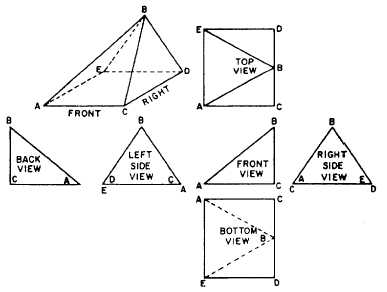plane (top and bottom views) and in the views on
the profile plane (right and left side views), the
line appears foreshortened. Note, however, that
you don’t need to calculate the amount of the
foreshortening, since it works itself out as you
project the various views.
CIRCLES IN MULTI-VIEW ORTHO-
GRAPHIC PROJECTION.— A circle on a
surface that is parallel to the plane of projection
will project as a circle. A circle on a surface that
is oblique to the plane of projection, however, will
project as an ellipse, as shown in figure 5-21. The
upper view in this figure is a top view of a wedge,
the wedge having a hole bored through it
perpendicular to the inclined face. The outline of
this hole on the front face of the wedge projects
as an ellipse in the front view. You get the minor
axis of the ellipse by projecting downward as
shown. The length of the major axis is equal to
the diameter of the hole.
Another ellipse is shown in the front view.
This is the partly hidden and partly visible outline
of the hole as it emerges through the back of the
wedge. The back of the wedge is parallel to the
front view plane of projection; therefore, this
ellipse is the true outline of the hole on the back
of the wedge. The outline is elliptical because the
hole, though it is circular, is bored obliquely to
the back face of the wedge.
To draw these ellipses, you could use any
of the methods of drawing an accurate ellipse
explained in the previous chapter on geometric
construction,
or you could use an ellipse
template.
AUXILIARY VIEWS.— In theory, there
are only three regular planes of projection:
the vertical, the horizonal, and the profile.
Actually, it is presumed that each of these is, as
it were, double; there is, for example, one
vertical plane for a front view and another for
a back view.
We assume, then, a total of six regular planes
of projection. A projection on any one of the six
is a regular view. A projection NOT on one of
the regular six is an AUXILIARY VIEW.
The basic rule of dimensioning requires that
a line be dimensioned only in the view in which
its true length is projected and that a plane with
its details be dimensioned only in the view in
which its true shape is represented. To satisfy this
rule, we have to create an imaginary plane that
is parallel with the line or surface we want to
project in its true shape. A plane of this kind
that is not one of the regular planes is called an
AUXILIARY PLANE.
In the upper left of figure 5-22, there is a
single-view projection of a triangular block,
the base of which is a rectangle. This block is
presumed to be placed for multi-view projection
Figure 5-22.-A line oblique to all planes of projection is foreshortened in all views.
5-13


